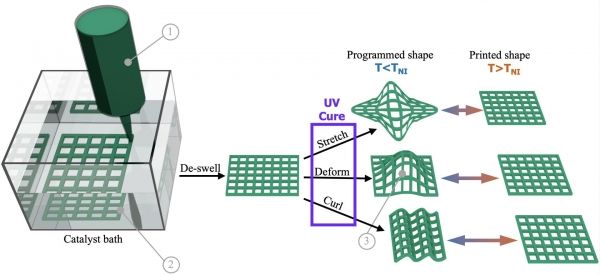Soft robots and biomedical implants that reconfigure themselves upon demand are closer to reality with a new way to print shapeshifting materials.
Rafael Verduzco and graduate student Morgan Barnes of Rice’s Brown School of Engineering developed a method to print objects that can be manipulated to take on alternate forms when exposed to changes in temperature, electric current or stress.
The researchers think of this as reactive 4D printing. Their work appears in the American Chemical Society journal ACS Applied Materials and Interfaces.
They first reported their ability to make morphing structures in a mold in 2018. But using the same chemistry for 3D printing limited structures to shapes that sat in the same plane. That meant no bumps or other complex curvatures could be programmed as the alternate shape.
Overcoming that limitation to decouple the printing process from shaping is a significant step toward more useful materials, Verduzco said.
“These materials, once fabricated, will change shape autonomously,” Verduzco said. “We needed a method to control and define this shape change. Our simple idea was to use multiple reactions in sequence to print the material and then dictate how it would change shape. Rather than trying to do this all in one step, our approach gives more flexibility in controlling the initial and final shapes and also allows us to print complex structures.”
Read more at Rice University
Image: A graphic shows the process by which a Rice University lab uses 3D printing to make shapeshifting materials that may be useful to make soft robots or as biomedical implants. Courtesy of the Verduzco Laboratory. CREDIT: Rice University


